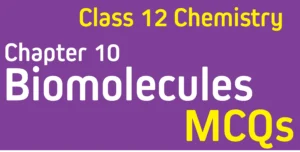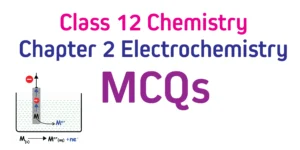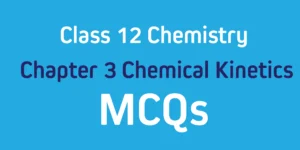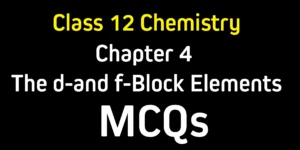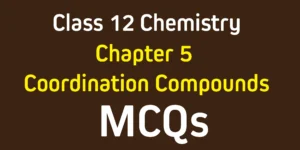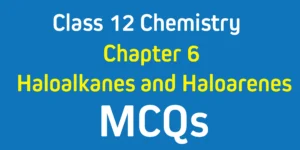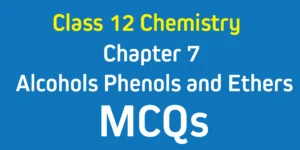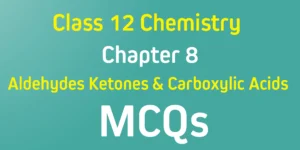Class 12 Chemistry – Chapter 1: Solutions (MCQs)
Click “Show Answer” to reveal the correct option and explanation
Answer: (b) Relative lowering of vapour pressure
Explanation: Colligative properties depend only on particle number (not nature). Relative lowering of vapour pressure is one such property.
Answer: (c) Molality of the solution
Explanation: ΔTb = Kb·m where m is molality.
Answer: (b) Mole fraction of solute
Explanation: (p0 − p)/p0 = xsolute.
Answer: (b) mol kg−1
Explanation: Molality is moles of solute per kilogram of solvent.
Answer: (b) Association/dissociation of solute
Explanation: i modifies colligative formulas to match the effective particle count.
Answer: (c) p = xApA0 + xBpB0
Explanation: Raoult’s law for both components with xA + xB = 1.
Answer: (b) Osmometer
Explanation: Osmometers determine π using semipermeable membranes.
Answer: (b) π = CRT
Explanation: C is molar concentration; analogous to ideal gas law.
Answer: (a) Molar mass of solute
Explanation: ΔTf = Kf·m allows calculation of molar mass.
Answer: (b) Decrease
Explanation: Higher KH means lower solubility (p = KHx).
Answer: (b) Weaker than pure components
Explanation: Leads to higher vapour pressure than ideal.
Answer: (b) Nature of solvent
Explanation: Kf and Kb are solvent properties.
Answer: (b) Molality
Explanation: Based on mass of solvent, not volume.
Answer: (c) < 1
Explanation: Association reduces particle number.
Answer: (c) i > 1 due to dissociation
Explanation: Electrolytes produce more particles than formula units.
Answer: (b) Benzene + Toluene
Explanation: Similar size and intermolecular forces → near-ideal behavior.
Answer: (b) Associates or dissociates in solution
Explanation: Particle number changes; need van’t Hoff factor correction.
Answer: (b) They cannot be separated by simple distillation
Explanation: Constant boiling mixtures boil without change in composition.
Answer: (b) Intermolecular attractions are stronger
Explanation: ptotal < pideal; exothermic mixing.
Answer: (d) Lowest molar mass, strong electrolyte
Explanation: More particles per gram (low M) and dissociation (higher i) → larger ΔTb.
Q.1: Which of the following is a colligative property?
(a) Boiling point
(b) Osmotic pressure
(c) Viscosity
(d) Surface tension
Explanation: Colligative properties depend on the number of solute particles in a solution, not on the nature of the solute. Osmotic pressure is one such property.
Q.2: The molality of a solution containing 18g of glucose (C₆H₁₂O₆) in 500g of water is:
(a) 0.1 m
(b) 0.2 m
(c) 0.5 m
(d) 1.0 m
Explanation: Molality (m) = moles of solute / mass of solvent (kg). Moles of glucose = 18/180 = 0.1 moles. Molality = 0.1 moles / 0.5 kg = 0.2 m.
Q.3: Raoult’s Law is applicable to:
(a) Non-ideal solutions
(b) Dilute solutions
(c) Ideal solutions
(d) Concentrated solutions
Explanation: Raoult's Law states that the partial vapor pressure of each volatile component in an ideal solution is directly proportional to its mole fraction.
Q.4: Which of the following statements is true for an ideal solution?
(a) ΔHmix = 0
(b) ΔVmix ≠ 0
(c) ΔHmix ≠ 0
(d) ΔVmix ≠ 0
Explanation: For an ideal solution, the enthalpy change of mixing (ΔH_mix) is zero because the intermolecular forces between the molecules of the solute and solvent are similar to those in the pure components.
Q.5: The boiling point of a solution increases if:
(a) Solute is non-volatile
(b) Solute is volatile
(c) Pressure is decreased
(d) None of the above
Explanation: Boiling point elevation occurs when a non-volatile solute is added to a solvent, increasing the boiling point of the solution compared to the pure solvent.
Q.6: Which of the following expresses Henry’s Law?
(a) P = k_H * x
(b) P = k_H / x
(c) P = x / k_H
(d) P = k_H + x
Explanation: Henry's Law states that the partial pressure of a gas in a liquid is directly proportional to the mole fraction of the gas in the liquid, where k_H is Henry's constant.
Q.7: The term used to describe the lowering of vapor pressure in a solution is:
(a) Relative lowering of vapor pressure
(b) Absolute lowering of vapor pressure
(c) Osmotic pressure
(d) Elevation of boiling point
Explanation: Relative lowering of vapor pressure is the ratio of the lowering of vapor pressure to the vapor pressure of the pure solvent, which is a colligative property.
Q.8: Which among the following is a suitable example of a colloidal solution?
(a) Salt in water
(b) Sugar in water
(c) Milk
(d) Benzene in water
Explanation: Milk is an example of a colloidal solution where fat globules are dispersed in water.
Q.9: When a non-volatile solute is added to a solvent, the vapor pressure of the solvent:
(a) Increases
(b) Decreases
(c) Remains the same
(d) None of the above
Explanation: The addition of a non-volatile solute decreases the vapor pressure of the solvent because the solute particles occupy space at the surface, reducing the number of solvent molecules that can escape into the vapor phase.
Q.10: The process of separation of solute particles from a solvent using a semi-permeable membrane is known as:
(a) Diffusion
(b) Osmosis
(c) Dialysis
(d) Filtration
Explanation: Osmosis is the process in which solvent molecules move through a semi-permeable membrane from a region of lower solute concentration to a region of higher solute concentration.
Q.11: Which of the following can show positive deviation from Raoult’s law?
(a) Ethanol and water
(b) Acetone and chloroform
(c) Benzene and toluene
(d) n-Hexane and n-Heptane
Explanation: Positive deviation from Raoult's law occurs when the intermolecular forces between the solute and solvent are weaker than those between the molecules of the pure components, as seen in the ethanol-water mixture.
Q.12: The freezing point of a solution is:
(a) Higher than the freezing point of the pure solvent
(b) Lower than the freezing point of the pure solvent
(c) Equal to the freezing point of the pure solvent
(d) None of the above
Explanation: Freezing point depression occurs when a solute is added to a solvent, causing the freezing point of the solution to be lower than that of the pure solvent.
Q.13: Which factor does not affect the solubility of a solid in a liquid?
(a) Temperature
(b) Pressure
(c) Nature of the solute and solvent
(d) Concentration
Explanation: The solubility of a solid in a liquid is influenced by temperature, pressure (in the case of gases), and the nature of the solute and solvent, but not by the concentration of the solution.
Q.14: A solution has a concentration of 1 ppm. This means:
(a) 1 g of solute in 1 L of solution
(b) 1 mg of solute in 1 L of solution
(c) 1 g of solute in 1 kg of solution
(d) 1 mg of solute in 1 kg of solution
Explanation: 1 ppm (part per million) corresponds to 1 milligram of solute in 1 liter of solution.
Q.15: Which of the following is not a method to express the concentration of a solution?
(a) Molality
(b) Molarity
(c) Normality
(d) Fluidity
Explanation: Molality, molarity, and normality are all methods to express the concentration of a solution, whereas fluidity is a measure of a liquid's flow characteristics.
Q.16: The process by which molecules of a solvent pass through a semi-permeable membrane from a dilute solution to a concentrated solution is called:
(a) Diffusion
(b) Osmosis
(c) Dialysis
(d) Filtration
Explanation: Osmosis is the process where solvent molecules move from a region of lower solute concentration to a region of higher solute concentration through a semi-permeable membrane.
Q.17: The addition of which of the following will not change the boiling point of water?
(a) NaCl
(b) C₂H₅OH
(c) CH₃OH
(d) H₂
Explanation: H₂ (hydrogen gas) does not dissolve significantly in water and hence will not affect its boiling point, unlike NaCl, C₂H₅OH, and CH₃OH which do.
Q.18: The van’t Hoff factor (i) for a dilute solution of K₄[Fe(CN)₆] is:
(a) 1
(b) 2
(c) 4
(d) 5
Explanation: K₄[Fe(CN)₆] dissociates into 4 K⁺ ions and 1 [Fe(CN)₆]⁴⁻ ion, giving a total of 5 particles in solution. Therefore, the van't Hoff factor (i) is 5.
Q.19: Which of the following solutions will have the highest boiling point?
(a) 1 M NaCl
(b) 1 M glucose
(c) 1 M sucrose
(d) 1 M urea
Explanation: NaCl dissociates into two ions (Na⁺ and Cl⁻) in solution, increasing the number of particles and hence the boiling point more than the non-electrolytes (glucose, sucrose, urea) which do not dissociate.
Q.20: The colligative property used to determine the molar mass of a solute is:
(a) Viscosity
(b) Surface tension
(c) Depression in freezing point
(d) Refractive index
Explanation: Depression in freezing point, a colligative property, is used to determine the molar mass of a solute by measuring the extent to which the freezing point of the solvent is lowered.
Q.21: The process of separating colloidal particles from impurities by means of diffusion through a semi-permeable membrane is called:
(a) Dialysis
(b) Osmosis
(c) Diffusion
(d) Filtration
Q.22: Which of the following substances will show minimum elevation in boiling point when dissolved in 1 kg of water?
(a) NaCl
(b) Urea
(c) K₂SO₄
(d) Glucose
Q.23: For a given solvent, the boiling point of a solution is always:
(a) Higher than that of the pure solvent
(b) Lower than that of the pure solvent
(c) Same as that of the pure solvent
(d) None of the above
Q.24: Which of the following statements is correct regarding a 0.1 M NaCl solution and a 0.1 M glucose solution?
(a) Both will have the same osmotic pressure
(b) NaCl solution will have higher osmotic pressure
(c) Glucose solution will have higher osmotic pressure
(d) Both will have the same boiling point
Q.25: The molality of a solution in which 0.5 mole of solute is dissolved in 250g of solvent is:
(a) 1 m
(b) 2 m
(c) 0.5 m
(d) 4 m
Q.26: The freezing point of a solution is affected by:
(a) The nature of the solute
(b) The amount of solute
(c) The nature of the solvent
(d) All of the above
Q.27: Which of the following has the highest van’t Hoff factor (i)?
(a) KCl
(b) Na₂SO₄
(c) BaCl₂
(d) Glucose
Q.28: Which of the following statements is not true for ideal solutions?
(a) They follow Raoult’s law over the entire range of concentration
(b) ΔH_mix = 0
(c) ΔV_mix = 0
(d) They are formed only by non-polar solvents
Q.29: The solubility of gases in liquids decreases with:
(a) Increase in pressure
(b) Increase in temperature
(c) Increase in concentration
(d) Decrease in temperature
Q.30: Which of the following solutions shows a negative deviation from Raoult’s law?
(a) Ethanol and acetone
(b) Benzene and toluene
(c) Chloroform and acetone
(d) Hexane and heptane
Q.31: The osmotic pressure of a solution increases with:
(a) Decrease in temperature
(b) Increase in temperature
(c) Increase in the number of solute particles
(d) Both (b) and (c)
Q.32: The ebullioscopic constant (Kb) depends on:
(a) Nature of the solute
(b) Nature of the solvent
(c) Temperature
(d) Both (a) and (b)
Q.33: The depression in freezing point is directly proportional to:
(a) The molarity of the solution
(b) The molality of the solution
(c) The normality of the solution
(d) The volume of the solution
Q.34: The boiling point of a liquid is the temperature at which its vapor pressure is equal to:
(a) 1 atm
(b) 1 torr
(c) The external pressure
(d) The atmospheric pressure
Q.35: The phenomenon of osmosis is due to:
(a) Diffusion of solute particles
(b) Diffusion of solvent particles
(c) Movement of solute particles against a concentration gradient
(d) None of the above
Q.36: An azeotropic mixture of two liquids has a boiling point:
(a) Higher than either of the pure components
(b) Lower than either of the pure components
(c) Same as the boiling point of the pure component with the lower boiling point
(d) Same as the boiling point of the pure component with the higher boiling point
Q.37: The term ‘isotonic solutions’ refers to:
(a) Solutions with the same concentration of solute
(b) Solutions with the same osmotic pressure
(c) Solutions with the same boiling point
(d) Solutions with the same freezing point
Q.38: Which of the following has the highest value of i (van’t Hoff factor)?
(a) NaCl
(b) K₂SO₄
(c) Al₂(SO₄)₃
(d) C₆H₁₂O₆
Q.39: Which of the following is a non-volatile solute?
(a) NaCl
(b) C₂H₅OH
(c) CH₃COOH
(d) CO₂
Q.40: Which of the following statements is incorrect?
(a) The boiling point of a solution is always higher than that of the pure solvent
(b) The freezing point of a solution is always lower than that of the pure solvent
(c) The vapor pressure of a solution is higher than that of the pure solvent
(d) The osmotic pressure of a solution is higher than that of the pure solvent
Q.41: Henry’s law constant (kH) is dependent on:
(a) Temperature
(b) Pressure
(c) Nature of the gas
(d) Both (a) and (c)
Q.42: A solution containing 10g of solute in 100g of solvent is referred to as:
(a) 10% (w/w) solution
(b) 10% (v/v) solution
(c) 10 ppm solution
(d) 10 molal solution
Q.43: The addition of a non-volatile solute to a solvent results in:
(a) Increase in vapor pressure
(b) Decrease in boiling point
(c) Decrease in freezing point
(d) Decrease in osmotic pressure
Q.44: The unit of molality is:
(a) mol/L
(b) mol/kg
(c) mol/g
(d) mol/m³
Q.45: The van’t Hoff factor (i) for a dilute solution of AlCl₃ is:
(a) 1
(b) 2
(c) 3
(d) 4
Q.46: Colligative properties depend on:
(a) The nature of solute particles
(b) The number of solute particles
(c) The chemical identity of the solute
(d) The physical state of the solute
Q.47: Which of the following solutions is not an example of a colloid?
(a) Milk
(b) Butter
(c) Salt in water
(d) Smoke
Q.48: The concentration term that is temperature-independent is:
(a) Molarity
(b) Molality
(c) Normality
(d) Volume percentage
Q.49: Which of the following will not change the vapor pressure of a solution?
(a) Changing the amount of solute
(b) Changing the nature of the solute
(c) Changing the temperature
(d) Changing the solvent
Q.50: The freezing point of 1 molal solution of a non-electrolyte in water is:
(a) 0°C
(b) -1.86°C
(c) -3.72°C
(d) 100°C
Q.51: The term ‘colligative properties’ refers to properties that:
(a) Depend on the chemical nature of the solute
(b) Depend on the number of solute particles
(c) Depend on the physical state of the solute
(d) Depend on the volume of the solvent
Q.52: The ratio of the number of moles of solute to the mass of solvent in kg is called:
(a) Molarity
(b) Molality
(c) Normality
(d) Volume percentage
Q.53: The vapor pressure of a solution is lower than that of the pure solvent because:
(a) Solute particles attract solvent particles
(b) Solute particles repel solvent particles
(c) Solute particles occupy space
(d) None of the above
Q.54: The solubility of a gas in a liquid at constant temperature is directly proportional to:
(a) The volume of the gas
(b) The pressure of the gas
(c) The temperature of the gas
(d) The nature of the gas
Q.55: Which one of the following statements about Raoult’s law is not correct?
(a) It is applicable to ideal solutions
(b) It relates vapor pressure of a solution to the mole fraction of the solvent
(c) It is valid over a wide range of concentrations
(d) It is not applicable to non-ideal solutions
Q.56: In a solution of two liquids, A and B, if the partial vapor pressure of A is higher than expected from Raoult’s law, the solution exhibits:
(a) Positive deviation
(b) Negative deviation
(c) No deviation
(d) Ideal behavior
Q.57: When the freezing point of a solvent is lowered upon the addition of a non-volatile solute, it is called:
(a) Boiling point elevation
(b) Freezing point depression
(c) Vapor pressure lowering
(d) Osmotic pressure
Q.58: Which one of the following does not affect the colligative properties of a solution?
(a) Nature of the solute
(b) Number of solute particles
(c) Concentration of solute particles
(d) Temperature
Q.59: A 0.1 M solution of which of the following substances will have the highest boiling point?
(a) NaCl
(b) KNO₃
(c) MgCl₂
(d) C₆H₁₂O₆
Q.60: The presence of which of the following will not affect the freezing point of water?
(a) NaCl
(b) Urea
(c) Ethanol
(d) Water



